Salamanders are small, soft-bodied animals with smooth skin and long tails. At first glance, they can remind you of lizards, but they live very different lives. One of the most surprising things about them is how much they change as they grow. Baby salamanders don’t just look like tiny adults, they start out looking more like little fish.
Baby salamanders are called larvae. They hatch in water, breathe with gills, and swim with finned tails. Their legs aren’t fully developed yet, so they look nothing like the adults they’ll become. Only after they go through big changes do they start to resemble the salamanders most people recognize.
Baby Salamanders Are Called Larvae
When salamander eggs hatch, the young are called larvae. These tiny babies are built for life in the water.
The most noticeable feature is their external gills. These look like feathery branches sticking out from the sides of their heads, and they pull oxygen straight from the water.

Larvae also have a tail fin that works like a fish’s tail, helping them move quickly in the water. Their legs are just tiny buds at first, not yet strong enough for walking.
Because of these features, baby salamanders look more like small fish than adult salamanders.
This body shape helps them survive in the water and escape predators.
Larvae Breathe Through External Gills
Adult salamanders usually breathe through their skin or lungs, but babies rely on their gills. These gills are covered in tiny blood vessels that soak up oxygen from the water around them.
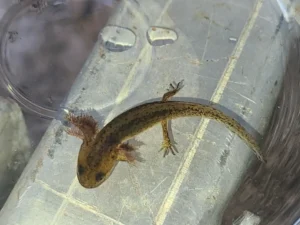
That means larvae have to stay underwater in places where the water is clean and has plenty of oxygen. If the water is polluted or still, it can be dangerous because oxygen levels drop.
The gills give baby salamanders their unique, almost alien look compared to the smooth-skinned adults.
Limbs Develop as Salamanders Grow
As the larvae grow, little legs begin to form. The front legs usually show up first, followed by the back legs. Over time, the legs get stronger and allow the salamander to walk on land.
This whole process is part of something called metamorphosis. This is a big change where they lose their gills, grow lungs, and their skin changes to match life outside of the water.
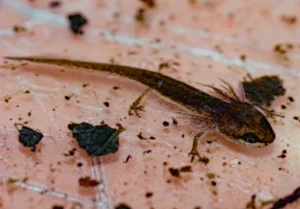
By the end of this stage, the salamander has transformed from a water-dwelling baby into the land-dwelling adult you’re more familiar with.
Baby Salamanders Have Different Colors
Larvae usually don’t share the same colors or patterns as adults. Instead, their skin is pale or even see-through, which helps them blend into their watery surroundings.
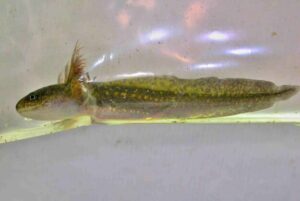
Some have spots or stripes that break up their outline, giving them even better camouflage.
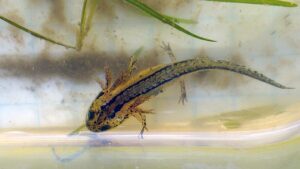
As they grow and change, their colors darken or shift into the patterns of adult salamanders. This helps them hide in forests, under logs, or wherever they end up living.
Some Species Skip the Larval Stage
Not every salamander starts out with gills and a finned tail. Some species use what’s called direct development. That means the young develop fully inside the egg and hatch as miniature adults, ready for life on land.
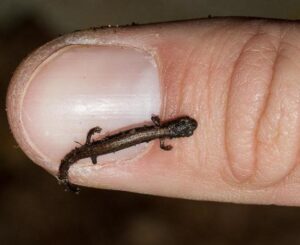
In these cases, the babies don’t have gills or a fish-like body. They come out looking like smaller versions of the adults, skipping the water stage completely. This happens more often in salamanders that live in places where water is scarce.
Baby Salamanders Are Easy Targets
Baby salamanders are soft, small, and have very few defenses. Their gills and tiny bodies make them an easy meal for fish, insects, and other predators.
To survive, they often hide under rocks, plants, or in mud. But even then, they’re at risk. If the water dries up, gets polluted, or flows too fast, many larvae won’t make it to adulthood.
Metamorphosis Is a Huge Change
The change from larva to adult is one of the biggest transformations in the animal world. Baby salamanders go from being fully aquatic to air-breathing animals that can live on land.
During this stage:
- Gills disappear as lungs take over.
- Limbs grow stronger for walking.
- The tail fin shrinks.
- Skin thickens to hold in moisture.
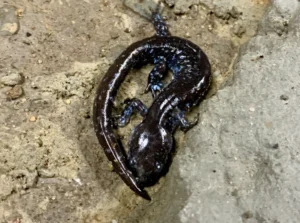
Depending on the species and conditions, this can take weeks or months. By the end, the salamander looks completely different from the baby that hatched out of the egg.
Why Baby Salamanders Matter
Even though they’re small, baby salamanders play an important role in their ecosystems.
- Larvae eat insects and tiny invertebrates, helping control populations.
- They also serve as food for larger animals, creating a link between water and land food chains.
- Healthy numbers of baby salamanders usually mean clean water and a balanced environment.
Conclusion
Baby salamanders don’t look anything like their parents when they first hatch. They start life as larvae with gills, finned tails, and weak legs, living fully underwater.
As they grow, they go through metamorphosis, losing their gills and growing lungs and limbs for life on land.
Some species skip this stage and hatch as miniature adults, but most take the longer route. Either way, the journey from baby to adult is full of challenges and shows just how unique salamanders really are.
Hi, my name is Ezra Mushala, i have been interested animals all my life. I am the main author and editor here at snakeinformer.com.

